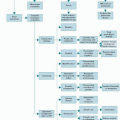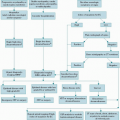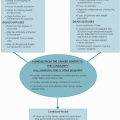Pathophysiology/Etiology
Hiccup is a primitive reflex that contains three parts. The afferent portion consists of branches of the vagus nerve, the phrenic nerve, and the sympathetic chain from T6 to T12. The hiccup center is located in the spinal cord between C3 and C5. The efferent limb is primarily the phrenic nerve with involvement of the efferents to the glottis and accessory muscles of respiration (
1).
In addition to the neural pathways, numerous anatomic structures are involved in the mechanism of hiccup (epiglottis, larynx, hyoid muscles, superior constrictor of the pharynx, esophagus, stomach, diaphragm, and exterior intercostal, sternocleidomastoid, anterior serratus, and scalene muscles). Given this extensive list, it is not surprising that hiccup has been associated with many conditions affecting the central nervous system (CNS), thorax, mediastinum, and abdominal viscera, although a cause-and-effect relationship has not always been clear. One report listed over 100 causes, the most common being an overdistended stomach (
3). Some cancer-related causes of persistent and intractable hiccups are listed in
Table 17.1.
Treatment/Management
Management is usually aimed at inhibiting or interrupting the irritated reflex arc. Nonpharmacologic therapies (
4) include the Valsalva maneuver (expiring forcefully against a closed glottis), ocular compression, carotid sinus massage, traction on the tongue, ice water gargles, noxious odors or tastes, breath holding, rebreathing into a paper bag, gagging, drinking from a glass while holding a pencil between the teeth or while bending over head down, taking as many sips of fluid as rapidly as possible without breathing, ingesting granulated sugar, biting a lemon wedge, or inducing emesis. Physical changes that may help stop hiccups include pulling the knees to chest, leaning forward to compress the chest, tapping over the fifth cervical vertebra, or applying ice over the phrenic nerve. Although these measures have not been subjected to controlled clinical trials, most are worth a try. However, many are not practical for these patients, who may be too debilitated to tolerate even simple maneuvers (e.g., holding breath).
Acupuncture may be a clinically useful, safe, and lowcost therapy for persistent hiccups in patients with cancer. In a recent retrospective case series, 16 adult male patients aged 27 to 71 with persistent cancer-related hiccups received one to three acupuncture sessions over a 1- to 7-day period. Thirteen patients experienced complete remission of persistent hiccups (
p < 0.0001) and three patients experienced decreased hiccups severity. Significant improvement was observed in discomfort (
p < 0.0001), distress (
p < 0.0001), and fatigue (
p = 0.0078) (
5).
Many drugs have been used to treat hiccups (
Table 17.2). The literature is largely based on case reports and no definitive clinical evidence is available to define the standard treatment. The only medication approved by the US Food and Drug Administration for hiccups is the antipsychotic phenothiazine chlorpromazine (25 to 50 mg through i.v., orally, or rectally three to four times a day) (
6). Chlorpromazine is less attractive in patients with cancer due to side effects of hypotension and sedation. Other medical therapies include haloperidol (1 to 5 mg orally three times daily or subcutaneously every 12 hours) (
7), nifedipine (10 mg p.o. three times daily) (
8), metoclopramide (10 mg p.o. or i.v. every 6 hours) (
9), and baclofen (10 to 20 mg p.o. three times a day) (
10).
Baclofen should be given with caution to the elderly due to frequent side effects of sedation, insomnia, dizziness, weakness, ataxia, and confusion (
10). If hiccups persist, amitriptyline (10 mg three times a day) (
11), carbamazepine (200 mg three times a day) (
12), diphenylhydantoin (200 mg i.v. and then 100 mg p.o. four times a day) (
13), or valproic acid (15 mg/kg/d in divided doses) (
14) can be administered. Midazolam has been successfully utilized in patients with terminal hiccups (
15). Midazolam infusion may be especially useful if intractable hiccups occur in the setting of refractory terminal delirium or agitation.
Gabapentin, an anticonvulsant, produces blockade of neural calcium channels and increases release of γ-aminobutyric acid (GABA), which may modulate diaphragmatic excitability. Case series have shown gabapentin
(300 mg p.o. three times daily with dose titration) to be effective in intractable hiccups (
16). In a retrospective study, 37 (3.9%) of 944 in-hospital patients and 6 (4.5%) of 134 patients observed at home presented with severe chronic hiccups. Gabapentin (300 mg three times a day with dose titration) was effective in these cases. Responses were observed in 32 patients (74.4%) with gabapentin at a dosage of 900 mg/d and in 9 patients (20.93%) at a dosage of 1,200 mg/d (
17). Gabapentin is not hepatically metabolized and has a relatively safe side-effect profile making it a potentially useful agent in the advanced cancer setting, especially among patients requiring adjuvant analgesia due to neuropathic cancer pain (
18,
19). Nebulized lidocaine maybe effective via a local anesthetic effect upon irritant sensory afferents and has a much greater safety profile than does the intravenous
route (
20). Similarly, nebulized saline solution has been reported by some authors to terminate hiccups in the palliative care setting (
21). Efficacy has been claimed for a variety of drugs that have a peripheral action such as atropine, edrophonium, procainamide, and quinidine. Methylphenidate (10 mg p.o. daily) is reported to be effective in the treatment of hiccups (
22).
Various invasive methods have been tried. As gastric distension is the most common cause of hiccups in patients with cancer, initial treatment should be aimed at relieving the distension and increasing gastric emptying. The insertion of a nasogastric tube may also serve the purpose by stimulating the pharynx or causing gagging. High-pressure oxygen inhalation has been tried. Percutaneous stimulation of the phrenic nerve has also been reported. Phrenic nerve injection may be a reasonable option for drug refractory hiccups if an experienced practitioner is available. In a case series, 1% lidocaine solution was administered via ultrasonographic guidance to the area of the phrenic nerve to five cancer patients with intractable hiccups. Hiccups ceased in all five patients within 5 minutes. Hiccups did not recur in three patients, and there were no adverse effects (
23). A surgical approach consists of an attack on the phrenic nerve (by a crush technique), usually first attempted on the left. Regardless of the treatment, in most cases, hiccups stop because of, or in spite of, therapeutic measures (
24,
25).
It is important to remember that hiccups in cancer may be extremely distressing and affect the quality of life by interfering with food intake, causing insomnia, or exacerbating pain and other symptoms. For this reason, it may be advisable to pursue diagnosis and treatment more aggressively than in the general population (
26).








